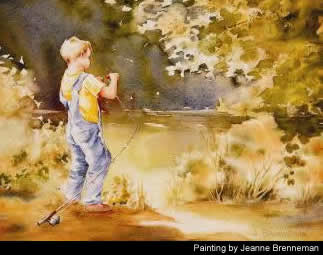

Fishing The Shores: How A Passion For Bass Fishing Helped Launch A Career In Wildlife Biology By Shawn Head I approached the bank of the pond with great anticipation. It was late afternoon. I provoked the wrath of a male red-winged blackbird on a weeping willow branch above me as I walked close to a high clump of weeds where his mate had her nest. She quickly exited. I looked down into the nest and could see the eggs. My neighbor had informed me the night before that largemouth bass had just started building their nests in the shallows close to the banks of the pond. He also told me to catch a dozen or so minnows and a half dozen small- to medium-sized frogs from the creek in my backyard when I got home from school and he would take me fishing at Mr. Dailey's pond. We went fishing that evening and caught three pre-spawning female bass in the four- to five-pound range. I realized this was it. I was really hooked and it was only going to get better--I was seven years old. I grew up in an area that had been a working cattle and horse farm but was quickly turning into a suburb. The various farm ponds that remained quickly became parts of people's properties and a part of my life. These ponds were stocked with bass and sunfish and I was fortunate to have permission to fish in all of them. As a result, some of the most exciting and memorable times of my life have been fishing from the banks or wading the shallows of these ponds for largemouth bass. But it wasn't just the thrill of catching bass that excited me. It was also the habitats I discovered and the animal life I observed within them that really grabbed my attention. Within these ponds and the adjacent surrounding land existed a diversity of wildlife and plant life that amazed me. I also realized these ponds and small marsh areas harbored more species of wildlife than any other habitat types around my home. Ever since I was in grade school I had a thirst for finding out all I could about the outdoor environment around me. I found myself looking for bird nests in the nearby shrubs and trees around my neighborhood. Over the years, it became easier to identify birds by the size, shape and materials of their nests. If it walked, crawled, hopped, slithered, swam, flew or grew in the ground, I had to know about it. I had to experience it, catch it, hold it, dig it up and read about it. Each trip to the ponds increased my thirst for knowledge about wildlife, their habits and their habitats. In visiting these ponds near my home, the anticipation of what I might see or experience was as exciting as the actual encounters I had with wildlife. Those experiences are as vivid today as they were over 40 years ago. Within walking distance of my home was a separate remote property that had a series of three ponds in close proximity to each other, surrounded by grown up grassy fields, shrub thickets and small tracts of woods. Two of these ponds had bass and sunfish. The third smaller pond harbored a variety of only turtles, frogs and snakes. This was called the turtle pond where I caught eastern painted turtles, common snapping turtles, spotted turtles, stink pot turtles, eastern garter snakes, northern water snakes, and a variety of frog species from bull frogs to chorus frogs. The incredible bass fishing and numerous wildlife encounters around these three ponds would take place for almost 15 years. About five years ago I decided to go back and see these three ponds. The area, as you can imagine, had grown up. I ruined a good pair of shoes, but it was worth it because these ponds and surrounding habitats had such a profound impact on my younger life and eventual career. At a young age, I realized that bass fishing and exploring ponds and the habitats around them opened the door to the natural world around me. I remembered these wildlife encounters and plant association experiences. It was not until I went to college and studied wildlife management, forestry and plant science, that I finally understood the associations between wildlife and specific plant communities. All of the experiences I had stored up started to unfold in front of me. In addition, I realized that you never stop learning. The study of wildlife and their habitats becomes a passion and lifelong commitment and you welcome it. One of the most important things about this story is that I had someone introduce me to fishing and the natural world. That person took the time to show me how to catch bait, bait a hook, use an artificial lure and how to land a fish. This in turn opened my eyes to the surrounding environment and the wildlife within it. So here's a twist! Instead of having your kids sit for endless hours watching television or playing video games, put down the remote, leave the cell phone at home, and take them hunting or fishing with you. Take them on a canoe trip, nature hike or camping trip. Many of the people I work with have had a multitude of different experiences over time that have helped shape and guide them into studying wildlife as a profession. I wanted to share some of the experiences that have had a direct influence on my life and my profession. The outdoor experiences you foster in children and young adults may well help shape their futures and their professional careers. I know they did for me. Shawn Head is a wildlife biologist stationed in Elkins. Painting is by Jeanne Brenneman/ www.jeannebrenneman.com . |
